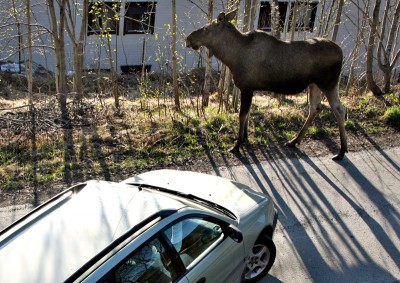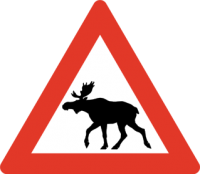Hardly a week has gone by this autumn without reports of serious collisions between vehicles and moose in Norway. A new study indicates motorists aren’t taking posted warnings about moose on the roads seriously.

Several of the accidents in recent weeks have been serious indeed, with one collision tearing off the entire roof of a car that hit a fully-grown moose on a country road in Østfold, southeast of Oslo. Both occupants of the car, young women in their 20s, were so badly injured that they were flown in separate helicopters to the country’s biggest hospital in the capital, in an effort to save their lives.
The early morning and early evening hours are generally the times of greatest moose danger on the roads, as the so-called “kings of the forest” emerge from the woods for grazing and often seek open areas. With their hormones in high gear at this time of year, the animals can be more active and aggressive as well. The annual moose hunt is expected to reduce their numbers, but Norway’s large moose population is likely to remain at high levels, boosting the collision danger.

Motorists ignore warning signs
Yet a new study conducted for insurance company Tryg indicates motorists don’t pay attention to the prominent moose warnings along state highways and local roads. News bureau NTB reports that nearly half of the motorists responding admitted they fail to reduce their speed when they see a warning sign for either moose or deer on the road.
Fully 45 responded that a collision with moose, deer and other large animals is what they fear the most while out driving, but the study suggests they’re not doing enough to avoid accidents.
Only 22 percent said they immediately reduce their speed when passing a warning sign, and then increase speed again gradually. Just 32 percent responded that they reduce speed and continue driving at a lower speed until the area of special danger has been passed.
Men aged 25 to 44 years were the least careful, according to the study, with few taking any special precautions or being especially attentive while driving through areas with a lot off moose or where moose migration tendencies are likely to bring them over roads.
Motorists in the counties of Agder and Rogaland were the least careful, followed by counties in northern Norway, reported NTB.
Views and News from Norway/Nina Berglund
Please support our stories! You can do so by clicking on the “Donate” button now:

